Which Domestic Shift Most Affected The Demographic Makeup Of Northern Us Cities In The Early 1900s?
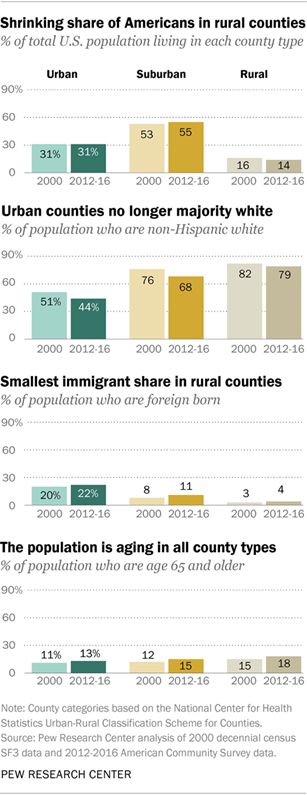 Iii key demographic forces have reshaped the overall U.S. population in recent years: growing racial and ethnic variety, increasing immigration and ascent numbers of older adults. But these trends are playing out differently in the nation's rural, urban and suburban communities, touching some more than than others.
Iii key demographic forces have reshaped the overall U.S. population in recent years: growing racial and ethnic variety, increasing immigration and ascent numbers of older adults. But these trends are playing out differently in the nation's rural, urban and suburban communities, touching some more than than others.
Likewise, recent U.Southward. population growth also has been uneven. Urban counties have grown at roughly the overall national rate of 13% since 2000. Suburban and modest metropolitan areas have grown more briskly. Rural counties have lagged, and half of them take fewer residents now than they did in 2000.
According to a Pew Enquiry Center analysis of demography data, since 2000, U.South. urban and suburban populations have grown at least every bit much as they did over the prior decade. But the total rural population has grown less than it did in the 1990s, when rising numbers fed hope of a modest "rural rebound." As a result, a somewhat smaller share of Americans now alive in rural counties (fourteen% vs. 16% in 2000).
More recently, the Census Bureau's population estimates for 2017 show a ane-twelvemonth uptick in the nation's rural population, though not enough to brand up for previous declines. Analysis by demographer Kenneth 1000. Johnson attributed the increase to gains in rural communities on the edge of metropolitan areas, while more remote counties connected to lose population.
This chapter compares three dissimilar types of communities among the nation's counties, based on a National Centre for Health Statistics (NCHS) classification system. The analysis covers three,130 of the nation's 3,142 counties and county equivalents such as parishes and independent cities. See Methodology for more than detail.
Urban cadre counties: These 68 counties – for example, Miami-Dade County, Milwaukee County and San Diego County – are located in the 53 U.S. metropolitan areas with at to the lowest degree a million people. In the NCHS nomenclature system they are called "large cardinal metro" counties, and about three-in-x Americans (31%) live in them. These counties are sometimes referred to merely as "urban" or "cities" in this study.
Suburban and small metro counties: These one,093 counties – sometimes called "suburbs" in this report – include those outside the core cities of the largest metro areas, as well as the entirety of other metropolitan areas. This group includes "large fringe metro," "medium metro" and "small metro" counties in the NCHS nomenclature system. About one-half of Americans (55%) live in suburban counties and smaller metropolitan areas, amid them New Haven County, Connecticut, DeKalb County (near Atlanta), and Boise Canton, Idaho.
Rural: These one,969 counties are located in non-metropolitan areas. Just 14% of Americans alive in them. These communities, with a median population size of xvi,535, include counties or canton equivalents such as Evangeline Parish, Louisiana; Navajo Canton, Arizona; and Elk County, Pennsylvania.
The flow of people in and out of different types of U.S. counties is affecting their size and composition. Since 2000, more than people left rural counties for urban, suburban or modest metro counties than moved in from those areas. Because there were not plenty new immigrants to starting time those departures, rural counties as a group grew but because they had more births than deaths.
At the national level, not-Hispanic whites make up the majority of the population, merely a key demographic shift is underway: Whites are a shrinking share of the population and expected to be less than half by midcentury as other groups grow more speedily. Whites have become a minority of the population in most urban counties since 2000, while remaining the majority in 90% of suburban and small metro counties and 89% of rural ones.
Some other key demographic tendency, the ascension in immigration in recent decades, has raised the foreign-born share of the U.South. population overall and has increased the share in each blazon of county, although to varying degrees. Immigrants, forth with their children and grandchildren, have accounted for the bulk of U.South. population growth since 1965. But immigrants are more than concentrated in cities and suburbs than in rural areas. On the flip side, the majority of rural counties now have fewer U.S.-born residents than in 2000, a key cistron in their dwindling populations.
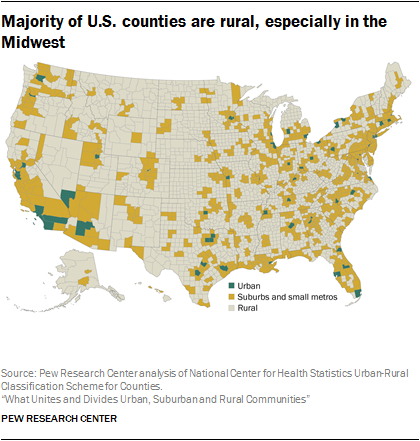 A tertiary major population commuter – the aging of the behemothic Baby Boom generation – also has varying impacts on different county types. Rural areas have a higher share of adults who are ages 65 and older than urban or suburban counties. But suburban counties have experienced the sharpest increases in the number of older adults since 2000.
A tertiary major population commuter – the aging of the behemothic Baby Boom generation – also has varying impacts on different county types. Rural areas have a higher share of adults who are ages 65 and older than urban or suburban counties. But suburban counties have experienced the sharpest increases in the number of older adults since 2000.
The assay in this chapter relies mainly on Census Bureau data. Current numbers for county characteristics come from the American Customs Survey (ACS) combined data for 2012-2016, the latest available. Current numbers for natural increment/decrease and migration flows come from population estimates for 2014, the about comparable year to the ACS data because it is the midpoint of the combined ACS data used in this chapter. See Methodology for more particular.
Suburbs growing more quickly than rural or urban areas
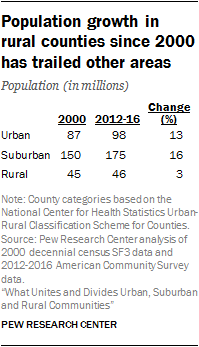 About 46 1000000 Americans alive in the nation's rural counties, 175 million in its suburbs and small metros and about 98 million in its urban core counties.
About 46 1000000 Americans alive in the nation's rural counties, 175 million in its suburbs and small metros and about 98 million in its urban core counties.
As a group, the population in rural counties grew three% since 2000, less than their viii% growth in the 1990s. Urban canton population rose xiii% since 2000 and the population in suburban and modest metro counties went up 16%, growth rates somewhat higher than in the 1990s.two The share of U.S. residents who alive in rural counties declined in the 1990s and since 2000, but rose in suburban counties during both periods and held steady in urban counties.
Although the rural population as a whole has grown since 2000, the majority of populations in individual rural counties have non. Since the turn of the century, the population declined in 52% of rural counties – 1,024 of one,969. Among the hardest striking counties were those where the economic system is based on farming, about a fifth of rural counties.
Growth factors vary for cities, suburbs and rural areas
At that place are iv main drivers of population proceeds or loss at the county level: births, deaths, new immigrants coming from away or leaving, and people moving to or from other U.S. counties (including immigrants already living in the U.S.). The demography numbers show that these factors are affecting cities, suburbs and rural communities differently.
Urban areas gained 1.6 million net new migrants since 2000, with a surplus of immigrants more than offsetting a loss of people who moved out to suburbs or rural areas. As a group, urban counties had 9.viii million more births than deaths, farther bolstering their populations.

Suburban and pocket-size metro counties have grown since 2000 because of gains in all the drivers of population modify. They gained 11.7 million new residents by drawing sometime residents of U.South. urban and rural areas, besides as immigrants from abroad. On top of that, they had 12.one 1000000 more births than deaths.
It was a different flick for rural counties, however, where motion-outs since 2000 exceeded move-ins. Equally a group, they had a net loss of 380,000 people who moved out. The loss would have been larger – more than 950,000 people – had information technology not been partly starting time past about 600,000 new immigrants. The total population of rural counties grew only through natural increment – that is, they had 1.2 million more than births than deaths.
Rural population loss largest in Midwest
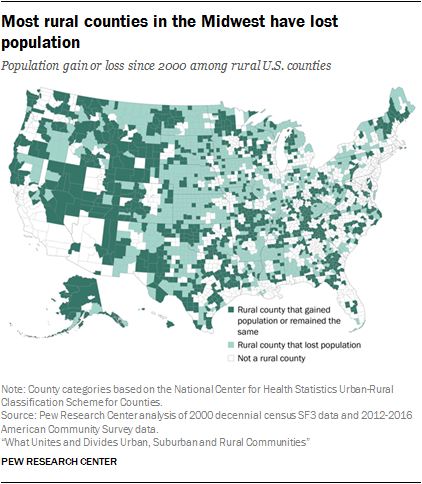 Patterns of births, deaths, migration and clearing vary greatly among regions, and generally illustrate the long-term tendency of Americans favoring the Sunbelt states of the South and West over Northeastern or Midwestern states. These regional differences persist within each canton type.
Patterns of births, deaths, migration and clearing vary greatly among regions, and generally illustrate the long-term tendency of Americans favoring the Sunbelt states of the South and West over Northeastern or Midwestern states. These regional differences persist within each canton type.
Among rural counties, a majority in the Northeast and Midwest lost population since 2000, while a majority in the South and especially the West gained population. One factor backside the regional difference is that rural counties in the Northeast and Midwest were more likely than other rural areas to have more deaths than births. These counties as well were more likely to have experienced a net loss of migrants – more people moving out than moving in.
The population trends of rural counties are linked to their economic profiles.3 As a group, the nation's 391 rural farming counties – heavily full-bodied in the Great Plains – have lost total population since 2000, while rural counties with other types of economies gained population.
 The full population of rural counties with recreation-based and regime-based economies grew more since 2000 than the populations of other rural county types. Ane reason recreation-based counties grew was that they had a net gain of new residents who moved from other U.Southward counties, the simply rural county type to have a gain in internet domestic migration. An analysis by the Population Reference Bureau found that rural recreation-based counties were peculiarly likely to have growing numbers of residents 65 and older, while rural farming-based counties were losing residents in that age grouping.
The full population of rural counties with recreation-based and regime-based economies grew more since 2000 than the populations of other rural county types. Ane reason recreation-based counties grew was that they had a net gain of new residents who moved from other U.Southward counties, the simply rural county type to have a gain in internet domestic migration. An analysis by the Population Reference Bureau found that rural recreation-based counties were peculiarly likely to have growing numbers of residents 65 and older, while rural farming-based counties were losing residents in that age grouping.
Amongst urban areas, the Midwest had the largest share of population-losing counties since 2000: 42% of urban counties in this region, including the ones that encompass Chicago (Cook County, Illinois), Detroit (Wayne County, Michigan), and Cleveland (Cuyahoga County, Ohio), lost population.
Amongst suburban and small metro counties, near a quarter of the ones in the Northeast and Midwest lost population since 2000, a higher share than in other regions. A majority of Northeast and Midwest suburban counties had a net proceeds of migrants, but that was mainly due to immigration. A bulk had a net loss of residents to urban or rural U.S. counties during this flow.
 A key demographic trend shaping the makeup of local populations, as well as the nation equally a whole, is the ascent number of older Americans. The Baby Boom generation, born betwixt 1946 and 1964, began turning 65 in 2011, and all will have reached that age by 2030.
A key demographic trend shaping the makeup of local populations, as well as the nation equally a whole, is the ascent number of older Americans. The Baby Boom generation, born betwixt 1946 and 1964, began turning 65 in 2011, and all will have reached that age by 2030.

While the population is aging in all three county types, this is happening more rapidly in U.S. suburban and small-scale metro counties. The 65-and-older population grew 39% in the suburbs since 2000, compared with 26% in urban and 22% in rural counties.
Nationally and in each county type, the older adult population grew more sharply since 2000 than any other age group – young children, school-age children, immature adults or eye-aged adults. In rural areas, the population younger than 18 declined during this menstruum. As a result, in each county type, adults ages 65 and older now make upward a larger share of the total population than in 2000.
As a group, rural counties skew older than suburban and urban counties: eighteen% of rural residents are 65 or older vs. 15% in suburban and small-scale metro counties and 13% in cities.
Rural counties also take a smaller share of immature adults than urban or suburban populations.
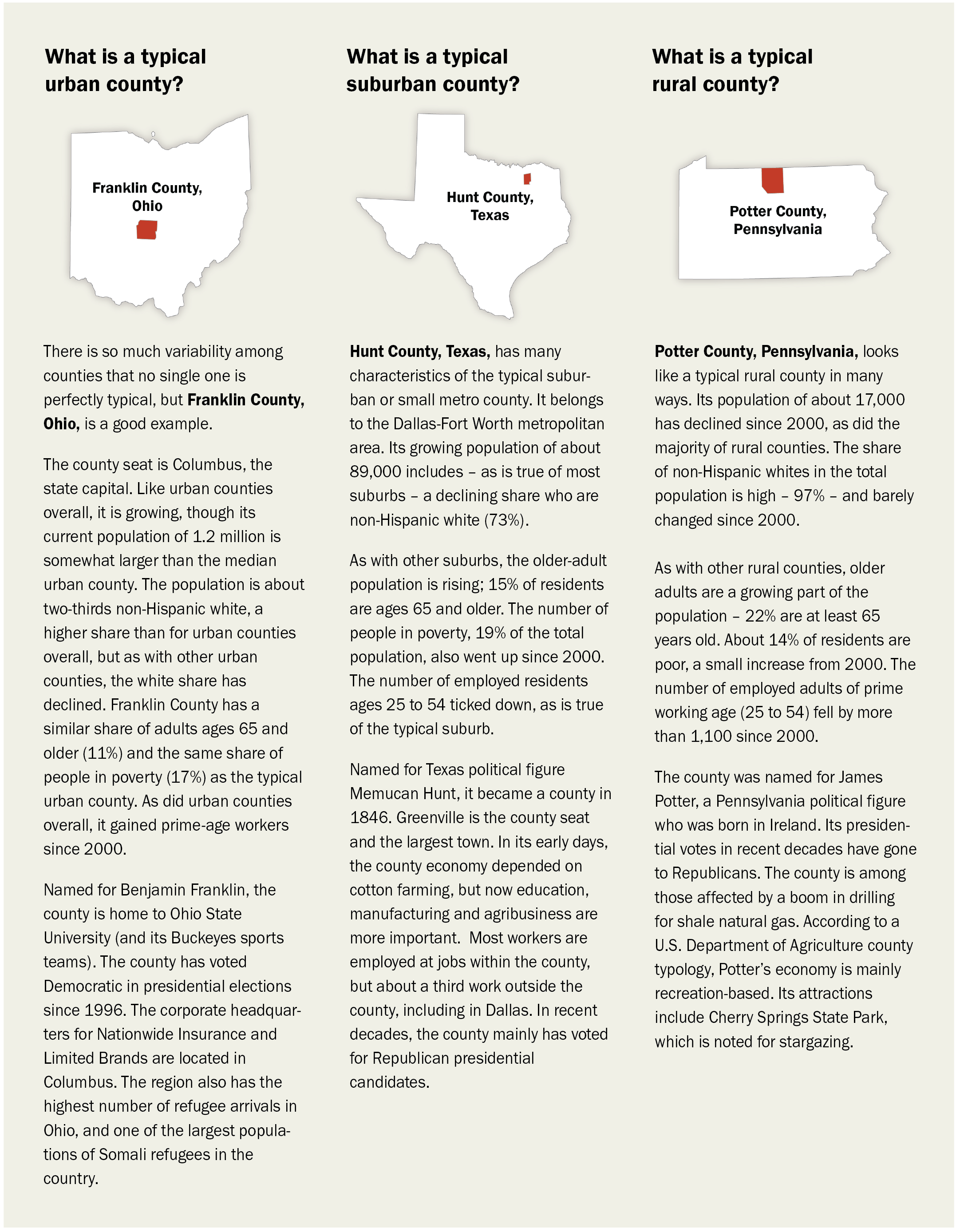
Urban and suburban counties are becoming more racially and ethnically various at a much faster pace than rural counties
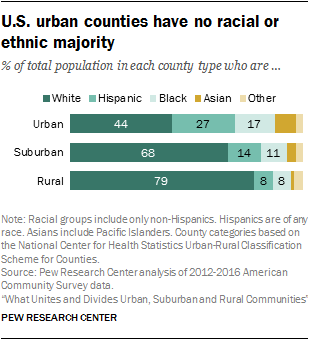 The nation is becoming more racially and ethnically various, but these changes have been more than muted in rural counties compared with urban and suburban ones. The white share of the population cruel 8 percentage points since 2000 in the suburbs, 7 points in the urban core and but 3 points in rural counties.
The nation is becoming more racially and ethnically various, but these changes have been more than muted in rural counties compared with urban and suburban ones. The white share of the population cruel 8 percentage points since 2000 in the suburbs, 7 points in the urban core and but 3 points in rural counties.
Overall, the U.S. population remains majority white, but not and then in urban areas every bit a group. Among urban residents, 44% are white, compared with 68% in suburban and small metro counties and 79% in rural counties. In fact, whites have get the minority in most urban counties (53% of them are majority nonwhite) since 2000; only about one-in-x suburban (10%) and rural (11%) counties are majority nonwhite.
While the share of the non-Hispanic whites has declined, the number of whites grew in the nation overall – and in suburban counties as a whole – since 2000. But the white population did not grow as sharply as other groups did, leading to a turn down in the white share of the total U.S. and suburban populations.
In urban counties, the reject in the share of the white population was due both to a decrease in the number of whites and an increase in the size of other populations, chiefly Hispanics.
In rural counties, the white population as well decreased and other groups as well increased in size, but the impact was more modest on the white share of the population because whites are and so big a proportion of rural residents.
 The foreign-built-in population is non evenly distributed beyond county types; immigrants tend to be concentrated in big metropolitan areas. In fact, nigh half alive in urban counties, where they make upward a higher share of the full than in suburban or rural counties.
The foreign-built-in population is non evenly distributed beyond county types; immigrants tend to be concentrated in big metropolitan areas. In fact, nigh half alive in urban counties, where they make upward a higher share of the full than in suburban or rural counties.
The immigrant share of the population grew since 2000 in the nation as a whole and in each county type. Immigrants were responsible for a larger share of overall growth in rural (37%) and urban (38%) counties than in suburban (26%) ones.
Although rural counties as a grouping accept more U.S.-born residents than in 2000, the majority of individual rural counties have fewer U.Due south.-born residents than in 2000. In that location is a large overlap between rural counties that have fewer U.Due south.-born residents than in 2000 and those that accept fewer full residents than in 2000. In the vast majority of rural counties that lost population – 1,011 out of 1,025 – the number of U.S.-born residents declined, and there were not enough new immigrants to offset the loss.
There are gaps in poverty, education and employment across canton types
In addition to the iii major demographic shifts that are reshaping urban, suburban and rural counties in the U.South. – the aging of the population, irresolute racial and ethnic makeup and the influx of new immigrants – there are meaning differences in other of import metrics beyond community types. These relate to the economic well-existence of their residents.
Poverty has increased more sharply in suburbs than in urban or rural counties
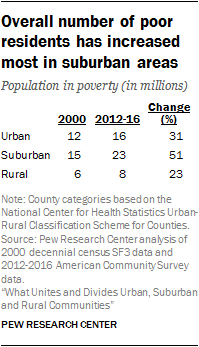 Overall, the poverty charge per unit is somewhat higher in rural (18%) and urban (17%) counties than in suburban ones (xiv%). Poverty rates have risen in all three county types since 2000.
Overall, the poverty charge per unit is somewhat higher in rural (18%) and urban (17%) counties than in suburban ones (xiv%). Poverty rates have risen in all three county types since 2000.
The number of people living in poverty also has risen beyond community types, merely the size of the poor population rose more than sharply in suburban counties than in urban or rural ones.
About half the U.S. poor population (49%) lives in suburban and pocket-sized metro counties, while 34% live in cities and 17% in rural areas.
But looking at the share of counties where at least a fifth of the population is poor – a measure out known as concentrated poverty – rural areas are at the top. Near 3-in-ten rural counties (31%) accept concentrated poverty, compared with 19% of cities and 15% of suburbs. The number of counties with concentrated poverty grew for all three canton types since 2000.
Growing share of residents of all county types take college degrees
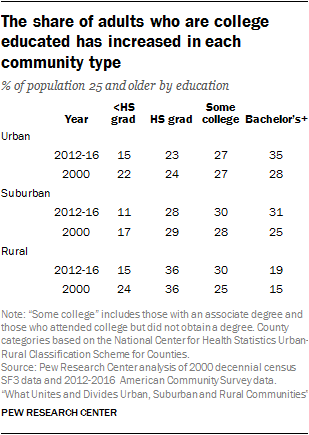 Growing shares of residents ages 25 and older accept graduated from college in all types of U.S. communities since 2000, though growth since 2000 was not as sharp every bit during the 1990s. Rural communities lag in the share of the population with a college degree.
Growing shares of residents ages 25 and older accept graduated from college in all types of U.S. communities since 2000, though growth since 2000 was not as sharp every bit during the 1990s. Rural communities lag in the share of the population with a college degree.
Today, 35% of urban residents and 31% in the suburbs have a bachelor's degree or more education, compared with 19% in rural counties. Rural areas as well trail urban and suburban areas in their share of residents with postgraduate degrees.
In urban and suburban counties overall, higher graduates outnumber residents with a loftier schoolhouse diploma and no further didactics, simply in the total rural population there are more high school graduates than college graduates. The share of residents who did not graduate from high school has dwindled in all three county types.
Rural counties lost prime-historic period workers, while urban and suburban areas gained them
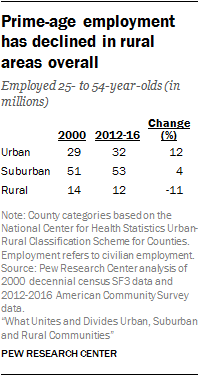 Rural counties also trail other types of communities, especially urban counties, on key measures of employment of prime-age workers – those 25 to 54 years onetime. For instance, 71% of rural residents of prime working age are employed, compared with 77% in both urban and suburban counties.
Rural counties also trail other types of communities, especially urban counties, on key measures of employment of prime-age workers – those 25 to 54 years onetime. For instance, 71% of rural residents of prime working age are employed, compared with 77% in both urban and suburban counties.
The number of employed adults in this age group (as well as the total number of prime working-historic period residents, employed or non) rose in urban areas as well as in suburban and small-scale metro areas since 2000, simply declined in rural counties overall. Rural counties at present are dwelling to a smaller share of the nation'southward prime-age workers than in 2000.
The growth in the prime-age working population was particularly abrupt in urban areas. As a issue, urban counties at present are home to a larger share of the nation'south prime number-age workers than in 2000.
In suburban areas, which also saw an increase in the number of prime-age workers since 2000, the flick looks somewhat less rosy when analyzed through some other lens – the experience of individual counties. Although the number of these workers grew for suburban counties as a grouping, a bulk of suburban counties (59%) accept fewer of them than in 2000. Among rural counties, 88% lost prime-age workers since 2000. Simply 29% of urban counties did.
 Another measure of economic health – average earnings per worker – is highest in urban counties and lowest in rural ones. These average earnings are lower now than in 2000 for all county types, reflecting lingering furnishings of the 2007-2009 recession, though average earnings in rural areas declined the least. (This more contempo measure is based on a v-twelvemonth boilerplate centered on 2014, reflecting earnings for the prior year. The 2000 figure reflects 1999 earnings.)
Another measure of economic health – average earnings per worker – is highest in urban counties and lowest in rural ones. These average earnings are lower now than in 2000 for all county types, reflecting lingering furnishings of the 2007-2009 recession, though average earnings in rural areas declined the least. (This more contempo measure is based on a v-twelvemonth boilerplate centered on 2014, reflecting earnings for the prior year. The 2000 figure reflects 1999 earnings.)
Which Domestic Shift Most Affected The Demographic Makeup Of Northern Us Cities In The Early 1900s?,
Source: https://www.pewresearch.org/social-trends/2018/05/22/demographic-and-economic-trends-in-urban-suburban-and-rural-communities/
Posted by: rodriguesaforeg.blogspot.com


0 Response to "Which Domestic Shift Most Affected The Demographic Makeup Of Northern Us Cities In The Early 1900s?"
Post a Comment